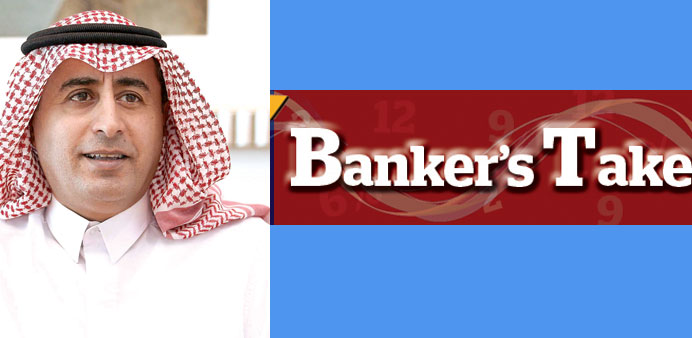By Dr Abdulaziz A al-Ghorairi
Following the decision in late 2014 by Opec not to cut oil production, the cost of a barrel of crude fell to its lowest in five years in mid-January this year. Although the price of oil has recovered marginally since then, it continues to trade significantly lower than its earlier peak.
Low oil prices spells bad news for many countries. Stock markets around the world have taken a beating following the oil price crash, with oil exporters bearing most of the brunt. Decreasing oil prices are expected to strengthen the dollar and a corresponding relative decline in the currencies of a number of emerging market economies who are particularly dependent of commodity exports. The decline in financial assets tied to oil may lead to widespread defaults of companies and countries, which will in turn precipitate financial contagion, leading to global financial instability.
Qatar, by contrast, appears almost immune to cheap oil. Whilst Qatar is a significant oil producer, it is predominantly a gas exporter and the price of its natural gas exports are only weakly correlated with oil. Qatar’s economic performance is expected to remain strong, thanks largely due to the solid expansion in non-hydrocarbon sector and wise fiscal planning. Whilst in nominal terms the economy grew by a slower rate of 5.2% over the first half of 2014 due to terms of-trade losses on sliding international oil prices, robust economic growth is still expected during 2014 to 2016. Despite the recent downtrend in oil prices, the Ministry of Development, Planning and Statistics kept 2014 GDP growth estimates unchanged at 6.3% in December 2014, while marginally reducing the 2015 forecast from 7.8% to 7.7%, making 2015 Qatar’s fastest year of expansion since 2011.
Non-hydrocarbon activities continue to drive overall economic momentum in Qatar, propelled by investment spending and population growth. In 2015, the non-hydrocarbon sector will account for more than half of nominal GDP, with construction expected to record the strongest growth among all economic sectors as planned public investment projects and infrastructure projects related to the FIFA World Cup 2022 gain momentum. Qatar’s banking sector also remains robust and despite growth in deposits slowing down in recent quarters, positive loan growth momentum has continued. With adequate capital bases and liquidity buffers, Qatar’s banking sector is in a strong position to overcome the near term hurdles caused by the oil price declines. Manufacturing had a sluggish performance in 2013 and 2014, but growth rates will rebound somewhat in 2015 and continue to pick up in 2016, contributing 8.9% of real GDP. The service sector contributes heavily to Qatar’s GDP and will continue to rise in addition to manufacturing and construction sectors.
In terms of the State budget, the government follows a conservative oil price approach for fiscal planning and Qatar also has huge fiscal reserves to cover any deficits in the near term. The fiscal balance for 2014/2015 targets an overall surplus of QAR7.2bn, considerably lower than 2013/2014 surplus of QAR108bn. Nevertheless, this indicates that Qatar is strong enough to face tumbling oil prices, especially when compared to its GCC peers. Lower oil and gas revenues are offset by higher investment income and Qatar has notably been accumulating substantial foreign assets through its sovereign investment vehicles. The accumulated value of Qatar’s current account surpluses over 2000 to 2014 amounts to $345.7bn, providing a strong cushion and resources to finance the budget and bear the near term hurdles of low oil prices.
Looking to the future, there is much uncertainty around the fluctuation of the oil prices and it is difficult to comment on when prices will begin to move upwards again. At present, declining oil prices are generally considered to be a temporary phenomenon due to weaker demand in a sluggish global economy and higher supply from US shale producers. The majority of US shale producers have a break-even point at $60 per barrel and at current weaker prices shale producers may find their business unviable, leading to lower future supply and a rebound in oil prices when global demand increases in coming years. In Qatar, government estimates assume full indexation of gas revenue to oil prices, giving break-even oil prices of $42 and $55 in 2014 and 2015 respectively. However, the break-even price is expected to increase to about $71 in 2016, as government expenditure continues to grow, oil production declines and Qatar Petroleum’s financial surplus moderates.
Qatar’s fiscal break-even oil price happily remains much below forecasted oil prices in 2015 and close to forecasted prices in 2016. Macroeconomic performance is expected to remain strong due to increased performance of the non-hydrocarbon sector and increased investment income, making Qatar’s break-even oil price much lower than our Opec peers. Although a future linked to oil prices (however loosely), is always uncertain, we believe Qatar will be able to comfortably sail through the hurdles caused by the recent fall in oil prices.
* The author is senior vice-president and group chief economist, Commercial Bank and director, National Bank of Oman and Alternatifbank. The views expressed are his own.



